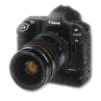|
There are, perhaps, more obvious training grounds for photojournalists than a two-year stint in the army, but World Press Photo of the Year winner Erik Refner is certain his military service has benefited his photography career. You can't see the reflection of your face on his shoes, and maybe he missed a shave this morning, but the importance of planning, communication and the ability to maintain a focused mind in difficult situations is not lost on this Danish sensation. "Planning a photographic assignment is very similar to setting up a military operation," Refner tells us. "Thinking ahead is essential if everything is to go smoothly and you are to get the pictures you want. Your equipment must be clean and ready to use at all times, and you have to understand your subject - you have to research it."
|
![[photo]](images/refner_01.gif)
|
|
Refner's first camera was a Canon EOS-1n and he has been using Canon ever since. "I chose the Canon system mostly for its speed," he says. "Since then I have become used to the way the cameras feel, work and the layout of the controls. Picking up the EOS-1Ds for the first time I felt at home immediately". Refner says he can't afford to have to think about where features and functions can be located when on assignment. "After working with EOS cameras for such a long time, I feel as though they have become part of my hand. Everything happens without me having to think, so I lose no time and miss nothing."
|

|
A question of speed
To Refner, a camera must be responsive. "A camera has to take the picture exactly when you press the shutter release," he emphasises. "The first digital camera to really achieve this, with almost no lag, was the EOS-1D, and the EOS-1Ds is following in this tradition." For high-pressure news reporting he will still rely on his eight frames per second EOS-1D, but the EOS-1Ds will be his tool of choice for less-hectic reportage, for portraits and studio work.
Refner prefers to work without flash for features and reporting. "For a lot of my work I am trying to capture the essence of an atmosphere, and also to blend into the surroundings, so subjects don't notice I'm there. Obviously, then, I hardly ever use flash, and load instead with ISO 400, 800 or 800 film up-rated to 1000, depending on the conditions. The sensitivity range on the EOS-1Ds runs from ISO 50 to ISO 1250 - more than enough for my needs. Best of all, I know at higher speeds the image quality does not suffer."
Love affair
Refner's enthusiasm for the new Canon EOS-1Ds is testament to the time and effort the company's designers and engineers have put into creating it. "I have fallen in love and decided to buy one for myself," he confesses. "Regardless of whether a camera is digital or takes film, you need excellent technical results every time. I used to shoot more film images than digital images, but now I can see the balance starting to change. Canon has already matched the speed of the best analogue with the EOS 1-D and resolution quality with the EOS 1-Ds. Canon's next challenge is to combine both into the one digital camera."
|
![[photo]](images/refner_03.gif)
|
